Echinodermata Study guides, Class notes & Summaries
Looking for the best study guides, study notes and summaries about Echinodermata? On this page you'll find 120 study documents about Echinodermata.
Page 2 out of 120 results
Sort by
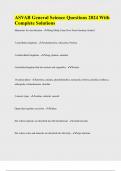
-
ASVAB General Science Questions 2024 With Complete Solutions
- Exam (elaborations) • 50 pages • 2024
-
- $12.99
- + learn more
Mnemonic for classification - King Philip Came Over From Germany Soaked 3 unicellular kingdoms - archaebacteria, eubacteria, Protista 3 multicellular kingdoms - fungi, plantae, animalia Unicellular kingdom that has nucleus and organelles - Protista 10 animal phyla - porifera, cnidaria, platyhelminthes, nematoda, rotifera, annelida, mollusca, arthropoda, echinodermata, chordate 3 muscle types - cardiac, skeletal, smooth Organ that regulates excretion - kidney Site where nutrients are abso...
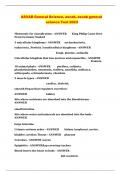
-
ASVAB General Science, asvab, asvab general science Test 2024
- Exam (elaborations) • 47 pages • 2024
-
- $15.49
- + learn more
ASVAB General Science, asvab, asvab general science Test 2024 Mnemonic for classification - ANSWER King Philip Came Over From Germany Soaked 3 unicellular kingdoms - ANSWER archaebacteria, eubacteria, Protista 3 multicellular kingdoms - ANSWER fungi, plantae, animalia Unicellular kingdom that has nucleus and organelles - ANSWER Protista 10 animal phyla - ANSWER porifera, cnidaria, platyhelminthes, nematoda, rotifera, annelida, mollusca, arthropoda, echinodermata, chordate 3 muscle types...
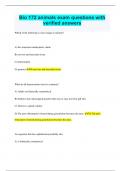
-
Bio 172 animals exam questions with verified answers
- Exam (elaborations) • 19 pages • 2024
- Available in package deal
-
- $9.99
- + learn more
Bio 172 animals exam questions with verified answers Which of the following is (are) unique to animals? A) the structural carbohydrate, chitin B) nervous and muscular tissue C) heterotrophy D) gametes B) nervous and muscular tissue What do all deuterostomes have in common? A) Adults are bilaterally symmetrical. B) Embryos have pharyngeal pouches that may or may not form gill slits. C) All have a spinal column. D) The pore (blastopore) formed during gastrulation becomes the anu...

-
Bio 117 exam 2 quiz with 100% correct solutions
- Exam (elaborations) • 49 pages • 2024
-
- $13.49
- + learn more
Bio 117 exam 2 quiz with 100% correct solutions Which of the following is NOT a characteristic of ALL animals? A. Heterotrophic B. Together, they form a monophyletic group. C. Multicellular organisms D. Cells lacking cell walls. E. All animals have true tissues and organs. - Correct Answer ️️ -All animals have true tissues and organs. Which of the following are characteristics of Phylum Cnidaria? (Select All that Apply) A. Specialized stinging cells B. True Tissues C. Comp...
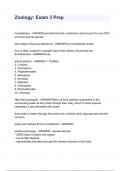
-
Zoology: Exam 3 Prep questions and answers
- Exam (elaborations) • 15 pages • 2024
-
- $7.99
- + learn more
invertebrates - ANSWER-animals that lack a backbone and account for over 95% of known animal species blue dragon (Glaucus atlanticus) - ANSWER-an invertebrate animal true or false: expect for sponges (and a few others), all animals are Eumetazoans - ANSWER-true animal phylum - ANSWER-1. Porifera 2. Cnidaria 3. Ctenophora 4. Platyhelminthes 5. Nematoda 6. Annelida 7. Mollusca 8. Arthropoda 9. Echinodermata 10. Chordata filter feed (sponges) - ANSWER-filter out food particles suspen...
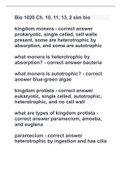
-
Bio 1020 Ch. 10, 11, 13, 2 sim bio (100% pass)
- Exam (elaborations) • 26 pages • 2023
-
- $16.49
- + learn more
kingdom monera prokaryotic, single celled, cell walls present, some are heterotrophic by absorption, and some are autotrophic what monera is heterotrophic by absorption? bacteria 00:25 01:28 what monera is autotrophic? blue-green algae kingdom protista eukaryotic, single celled, autotrophic, heterotrophic, and no cell wall what are types of kingdom protista paramecium, amoeba, and euglena paramecium heterotrophic by ingestion and has cilia ...
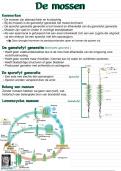
-
Evolutie en Biodiversiteit samenvatting deeltoets 2 van het plantenrijk, invertebraten en chordata.
- Summary • 13 pages • 2023 Popular
-
- $3.96
- 1x sold
- + learn more
In het document is voor elk van de volgende planten groepen in het planten rijk een samenvatting gemaakt: de mossen, de wolfsklauwachtigen de varenachtigen, de naaktzadigen, de bedektzadigen. Hierbij wordt voor elk aangegeven wat hun kenmerken zijn, hun belang, hun levenscyclus en nog uitleg over andere belangrijke eigenschappen. Hierna zijn ook de volgende fylums samengevat van het dierenrijk: de porifera, de cnidaria, de platyhelminthes, de nematoda, de mollusca, de annelida, de arthropoda, de...
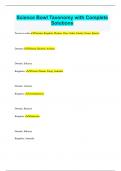
-
Science Bowl Taxonomy with Complete Solutions
- Exam (elaborations) • 4 pages • 2024
- Available in package deal
-
- $8.99
- + learn more
Science Bowl Taxonomy with Complete Solutions Taxons in order Domain, Kingdom, Phylum, Class, Order, Family, Genus, Species Domains Eukarya, Bacteria, Archaea Domain: Eukarya Kingdoms: Protista, Plantae, Fungi, Animalia Domain: Archaea Kingdom: Archaebacteria Domain: Bacteria Kingdom: Eubacteria Domain: Eukarya Kingdom: Animalia Phylum: Porifera, Cnidaria, Platyhelminthes, Nematoda, Annelida, Arthropoda, Mollusca, Echinodermata, Chordata Phylum: Species: Huma...
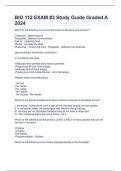
-
BIO 112 EXAM #3 Study Guide Graded A 2024
- Exam (elaborations) • 8 pages • 2024
-
- $11.49
- + learn more
Which of the following is an incorrect match of structure and function? Cnidocyte - capturing prey Parapodia - defense from enemies Radula - obtaining food Mantle - secretes the shell Chelicerae - consuming food - Parapodia - defense from enemies (gas exchange, locomotion, protection) In a cnidarian life cycle, -Medusae have gonads and produce gametes -Polyps bud off from other polyps -Medusae bud off from polyps -Polyps grow from ciliated larvae - All of the above ...
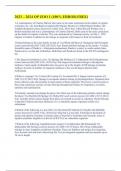
-
2023 – 2024 OP ZOO 1 (100% ERROR-FREE)
- Exam (elaborations) • 57 pages • 2023
-
- $14.49
- + learn more
1.A contemporary of Charles Darwin who came to the same conclusion in the matter of organic evolution was- (A) Jean Baptist Lamarck (B) Thomas Huxley (C) Alfred Russel Wallace (D) Franklin Benjamin correct answers (C) (SSC CGL 2014) Exp: Alfred Russell Wallace was a British naturalist and was a contemporary of Charles Darwin, Both came to the same conclusion on the matter of organic evolution. This was announced by Linnaean society, on July 1, 1958. Organic evolution is defined as the change in ...

How much did you already spend on Stuvia? Imagine there are plenty more of you out there paying for study notes, but this time YOU are the seller. Ka-ching! Discover all about earning on Stuvia


